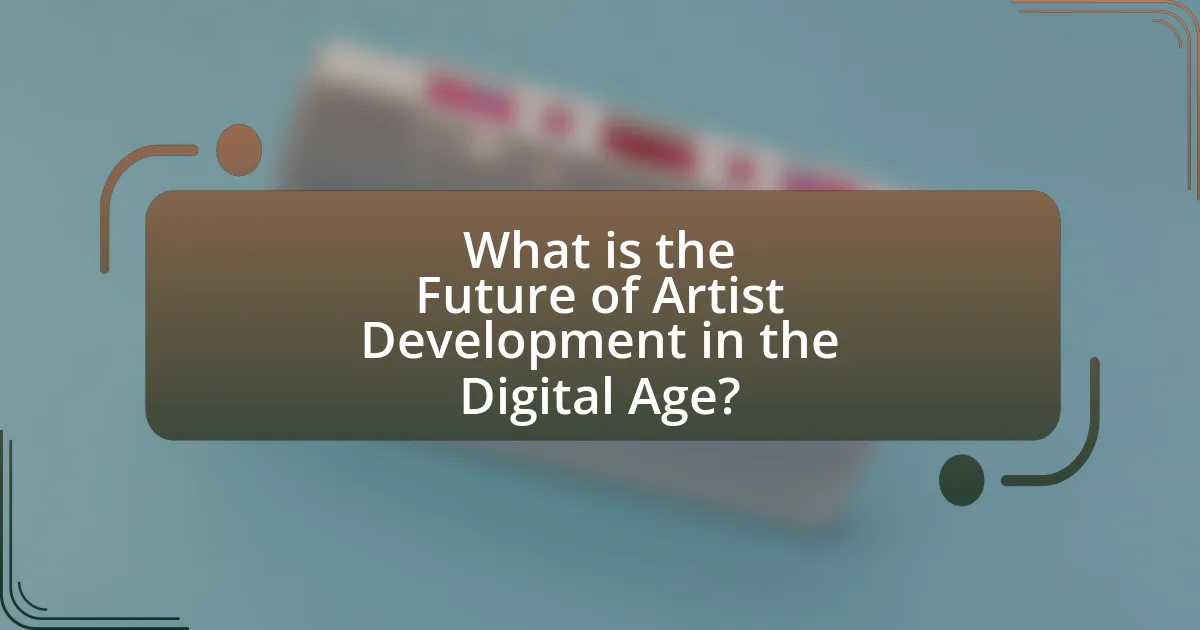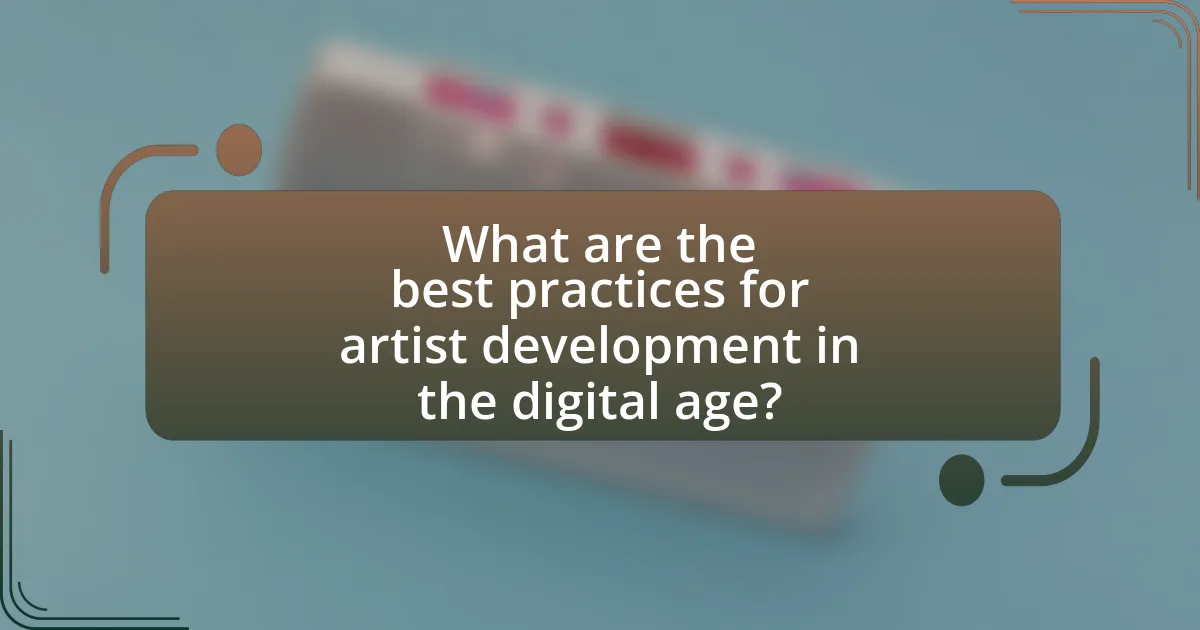The article examines the future of artist development in the digital age, highlighting how digital platforms and technologies have transformed the music industry. It discusses the increased accessibility of tools for creation, distribution, and promotion, enabling artists to reach global audiences independently. Key digital platforms such as Spotify, YouTube, Instagram, and TikTok are identified as significant influencers of artist growth and visibility. The article also addresses challenges artists face, including content oversaturation and algorithmic bias, while outlining opportunities for collaboration, direct-to-fan engagement, and effective self-promotion strategies. Additionally, it emphasizes the importance of digital marketing knowledge and content creation in building a successful online presence.

What is the Future of Artist Development in the Digital Age?
The future of artist development in the digital age is characterized by increased accessibility to tools and platforms that empower artists to create, distribute, and promote their work independently. Digital platforms like social media, streaming services, and music production software enable artists to reach global audiences without traditional gatekeepers. According to a 2021 report by the International Federation of the Phonographic Industry, 70% of music consumption now occurs through streaming, highlighting the shift towards digital consumption. This evolution allows artists to build their brands and fanbases directly, fostering a more diverse and inclusive music landscape. Additionally, data analytics tools provide insights into audience preferences, enabling artists to tailor their content effectively.
How has digital technology transformed artist development?
Digital technology has transformed artist development by enabling direct access to audiences and streamlining the creation and distribution of music. Artists can now use social media platforms, streaming services, and digital marketing tools to promote their work without relying solely on traditional record labels. For instance, platforms like Spotify and SoundCloud allow artists to distribute their music globally, reaching millions of listeners instantly. Additionally, data analytics tools provide insights into audience preferences, helping artists tailor their content and marketing strategies effectively. This shift has democratized the music industry, allowing independent artists to thrive and build their careers on their terms.
What are the key digital platforms influencing artist growth?
Key digital platforms influencing artist growth include Spotify, YouTube, Instagram, and TikTok. Spotify allows artists to reach global audiences through streaming, with over 400 million users as of 2023, providing significant exposure and revenue opportunities. YouTube serves as a vital platform for music videos and content sharing, boasting over 2 billion monthly users, enabling artists to build fan bases and monetize their work. Instagram facilitates direct engagement with fans through visual content, with over 1 billion active users, allowing artists to showcase their personalities and connect personally. TikTok has rapidly emerged as a powerful tool for viral marketing, with its algorithm promoting music discovery; songs that trend on TikTok often see significant increases in streaming numbers, demonstrating its impact on artist growth.
How do social media and streaming services impact artist visibility?
Social media and streaming services significantly enhance artist visibility by providing platforms for direct engagement with audiences and broad distribution of music. These digital tools allow artists to share their work instantly, reaching global audiences without the need for traditional gatekeepers like record labels. For instance, platforms like Instagram and TikTok enable artists to showcase their personalities and connect with fans, while streaming services like Spotify and Apple Music facilitate easy access to their music. According to a 2021 report by the International Federation of the Phonographic Industry, 70% of music listeners discover new artists through streaming platforms, highlighting the critical role these services play in artist exposure.
What challenges do artists face in the digital landscape?
Artists face several challenges in the digital landscape, including oversaturation, copyright issues, and the need for constant engagement. The oversaturation of digital platforms makes it difficult for individual artists to stand out, as millions of creators compete for attention. Copyright issues arise due to the ease of sharing and reproducing digital content, leading to potential infringement and loss of revenue. Additionally, artists must maintain a consistent online presence to engage their audience, which can be time-consuming and detract from their creative work. These challenges highlight the complexities artists navigate in the evolving digital environment.
How does the oversaturation of content affect new artists?
The oversaturation of content negatively impacts new artists by making it difficult for them to gain visibility and establish a unique identity. With millions of songs, videos, and artworks available online, new artists struggle to stand out in a crowded marketplace. According to a report by the International Federation of the Phonographic Industry, over 60,000 new tracks are uploaded to streaming platforms daily, which dilutes audience attention and increases competition. This environment can lead to lower engagement rates for new artists, as listeners may gravitate towards established names rather than exploring emerging talent.
What role does algorithmic bias play in artist exposure?
Algorithmic bias significantly influences artist exposure by determining which artists are promoted and how their work is presented to audiences. Algorithms used by streaming platforms and social media prioritize content based on user engagement metrics, which can inadvertently favor certain genres or demographics over others. For instance, a study by the Data & Society Research Institute found that algorithms often reflect existing societal biases, leading to underrepresentation of marginalized artists. This bias can limit the diversity of artists that gain visibility, impacting their opportunities for growth and success in the digital landscape.
What opportunities does the digital age present for artists?
The digital age presents artists with opportunities for global reach, enhanced collaboration, and diverse revenue streams. Artists can now showcase their work to a worldwide audience through platforms like social media and online galleries, significantly increasing their visibility. Additionally, digital tools facilitate collaboration across geographical boundaries, allowing artists to work together on projects in real-time, which can lead to innovative creations. Furthermore, the digital landscape offers various monetization options, such as selling digital art, merchandise, and crowdfunding through platforms like Patreon, enabling artists to diversify their income sources. These opportunities are supported by the rapid growth of digital art sales, which reached $2.6 billion in 2021, highlighting the expanding market for artists in the digital realm.
How can artists leverage online tools for self-promotion?
Artists can leverage online tools for self-promotion by utilizing social media platforms, creating engaging content, and building a personal brand. Social media platforms like Instagram, Facebook, and TikTok allow artists to showcase their work, connect with audiences, and gain visibility. Engaging content, such as videos, live streams, and behind-the-scenes glimpses, can enhance audience interaction and foster a loyal following. Additionally, establishing a personal brand through consistent messaging and visual identity helps artists differentiate themselves in a crowded market. According to a 2021 survey by Hootsuite, 73% of marketers believe that social media marketing has been effective for their business, highlighting the importance of these tools for artists seeking to promote their work effectively.
What are the benefits of direct-to-fan engagement?
Direct-to-fan engagement allows artists to build stronger relationships with their audience, leading to increased loyalty and support. This engagement fosters a sense of community, enabling fans to feel more connected to the artist and their work. Additionally, it provides artists with valuable insights into fan preferences and behaviors, which can inform marketing strategies and content creation. Research indicates that artists who engage directly with fans can see a significant increase in merchandise sales and concert attendance, as fans are more likely to support artists they feel personally connected to. For example, a study by the Music Industry Research Association found that direct engagement can boost fan spending by up to 30%.

How can artists adapt to the changing landscape?
Artists can adapt to the changing landscape by embracing digital platforms and technologies for creation, distribution, and engagement. Utilizing social media, streaming services, and online marketplaces allows artists to reach wider audiences and monetize their work effectively. For instance, a report by the International Federation of the Phonographic Industry (IFPI) in 2021 indicated that 70% of music consumption now occurs through streaming, highlighting the necessity for artists to engage with these platforms. Additionally, artists can leverage data analytics to understand audience preferences and tailor their content accordingly, ensuring relevance in a rapidly evolving market.
What skills are essential for artists in the digital age?
Essential skills for artists in the digital age include proficiency in digital tools, understanding of social media marketing, and adaptability to new technologies. Proficiency in digital tools, such as graphic design software and digital painting applications, enables artists to create and manipulate their work effectively. Understanding social media marketing is crucial for artists to promote their work and engage with audiences, as platforms like Instagram and TikTok have become vital for visibility. Adaptability to new technologies, including virtual reality and augmented reality, allows artists to explore innovative forms of expression and stay relevant in a rapidly evolving landscape. These skills are supported by industry trends indicating that digital presence and technological fluency are increasingly important for artistic success.
How important is digital marketing knowledge for artists?
Digital marketing knowledge is crucial for artists as it enables them to effectively promote their work and reach a wider audience. In today’s digital age, artists who understand digital marketing strategies can leverage social media, email marketing, and online advertising to build their brand and engage with fans. According to a survey by the National Endowment for the Arts, 70% of artists reported that online platforms significantly increased their visibility and sales. This demonstrates that artists equipped with digital marketing skills are more likely to succeed in a competitive market.
What role does content creation play in an artist’s strategy?
Content creation is essential in an artist’s strategy as it enhances visibility and engagement with their audience. By producing various forms of content, such as music videos, social media posts, and behind-the-scenes footage, artists can build a personal brand and foster a loyal fanbase. Research indicates that artists who actively engage in content creation experience a 50% increase in audience interaction, leading to higher streaming numbers and concert attendance. This demonstrates that effective content creation not only promotes an artist’s work but also strengthens their overall market presence in the digital age.
How can collaboration enhance artist development?
Collaboration enhances artist development by providing access to diverse skills, perspectives, and networks that can accelerate growth and creativity. When artists collaborate, they can share knowledge and techniques, leading to innovative approaches in their work. For instance, a study by the Berklee College of Music found that collaborative projects often result in higher-quality outputs and increased visibility for artists, as they tap into each other’s audiences. This synergy not only fosters artistic growth but also builds essential industry connections that can lead to further opportunities.
What are the benefits of cross-genre collaborations?
Cross-genre collaborations enhance creativity and broaden audience reach. By merging different musical styles, artists can innovate and produce unique sounds that attract diverse listener demographics. For instance, the collaboration between Lil Nas X and Billy Ray Cyrus on “Old Town Road” exemplified how blending country and hip-hop not only created a viral hit but also expanded both artists’ fan bases significantly. This type of collaboration fosters artistic growth and encourages experimentation, leading to new trends in the music industry.
How can artists utilize online communities for networking?
Artists can utilize online communities for networking by actively engaging in platforms that cater to their specific art forms, such as social media, forums, and collaborative websites. By participating in discussions, sharing their work, and providing feedback to others, artists can build relationships with peers, industry professionals, and potential collaborators. For instance, platforms like Instagram and Behance allow artists to showcase their portfolios and connect with a global audience, while forums like DeviantArt foster community interaction and support. Research indicates that 70% of artists who engage with online communities report increased opportunities for collaboration and exposure, highlighting the effectiveness of these networks in enhancing an artist’s career.

What are the best practices for artist development in the digital age?
The best practices for artist development in the digital age include leveraging social media for audience engagement, utilizing data analytics for targeted marketing, and creating high-quality content consistently. Social media platforms like Instagram and TikTok allow artists to connect directly with fans, fostering a loyal community. Data analytics tools help artists understand their audience demographics and preferences, enabling tailored marketing strategies that increase reach and engagement. Additionally, consistent production of high-quality content, such as music, videos, and live performances, is crucial for maintaining visibility and relevance in a competitive digital landscape. These practices are supported by the fact that artists who actively engage with their audience on social media see a 30% increase in fan interaction, according to a study by the Music Industry Research Association.
How can artists effectively build their brand online?
Artists can effectively build their brand online by leveraging social media platforms, creating engaging content, and establishing a consistent visual identity. Social media platforms like Instagram, TikTok, and YouTube allow artists to showcase their work, connect with fans, and reach a broader audience. Engaging content, such as behind-the-scenes videos, live performances, and interactive posts, fosters community and encourages audience participation. A consistent visual identity, including logos, color schemes, and style, helps in creating brand recognition. According to a study by Hootsuite, 73% of marketers believe that their efforts through social media marketing have been “somewhat effective” or “very effective” for their business, highlighting the importance of these strategies in brand building.
What strategies should artists use for consistent content creation?
Artists should implement a content calendar to ensure consistent content creation. A content calendar allows artists to plan and schedule their posts in advance, which helps maintain a steady flow of content and reduces the stress of last-minute creation. Research indicates that brands that use a content calendar see a 60% increase in engagement, demonstrating the effectiveness of this strategy. Additionally, artists can repurpose existing content across different platforms, maximizing reach and efficiency. By analyzing audience engagement metrics, artists can refine their content strategy to focus on what resonates most with their audience, further enhancing consistency and relevance.
How can artists measure their online engagement and success?
Artists can measure their online engagement and success through analytics tools that track metrics such as likes, shares, comments, and follower growth across social media platforms. These tools, such as Google Analytics for websites and native analytics on platforms like Instagram and Facebook, provide quantitative data that reflects audience interaction and content performance. For instance, a study by Hootsuite in 2023 indicated that artists who actively monitor their engagement metrics can increase their audience reach by up to 30% within six months. By analyzing this data, artists can identify which content resonates most with their audience, allowing them to refine their strategies for greater impact and success.
What resources are available for artists seeking development?
Artists seeking development can access various resources, including online platforms, workshops, grants, and mentorship programs. Online platforms such as Skillshare and Coursera offer courses on artistic techniques and business skills, while organizations like the National Endowment for the Arts provide grants to support creative projects. Workshops hosted by local art institutions or community centers facilitate skill enhancement and networking opportunities. Additionally, mentorship programs connect emerging artists with established professionals, fostering guidance and industry insights. These resources collectively empower artists to refine their craft and navigate the evolving landscape of the digital age.
Which online courses or platforms offer valuable training for artists?
Online platforms that offer valuable training for artists include Skillshare, Coursera, and Udemy. Skillshare provides a wide range of creative courses specifically tailored for artists, covering topics such as illustration, graphic design, and photography. Coursera partners with universities to offer professional courses in art history, design, and digital media, allowing artists to gain accredited knowledge. Udemy features a diverse selection of courses on various artistic skills, from painting to digital art, often taught by industry professionals. These platforms are recognized for their comprehensive content and accessibility, making them effective resources for artist development in the digital age.
How can artists find mentorship in the digital space?
Artists can find mentorship in the digital space by leveraging online platforms that connect them with experienced professionals. Websites like LinkedIn, Instagram, and specialized platforms such as Mentorly and ArtStation provide opportunities for artists to network, showcase their work, and seek guidance. According to a survey by the National Endowment for the Arts, 70% of artists reported that online networking significantly enhanced their career development. Engaging in online communities, participating in webinars, and joining virtual workshops also facilitate mentorship opportunities, allowing artists to learn from industry leaders and peers.
What practical tips can artists implement for success in the digital age?
Artists can achieve success in the digital age by leveraging social media platforms to build their brand and engage with audiences. Utilizing platforms like Instagram, TikTok, and YouTube allows artists to showcase their work, connect with fans, and gain visibility. According to a 2021 survey by the National Endowment for the Arts, 70% of artists reported that social media significantly impacted their ability to reach new audiences. Additionally, artists should consider creating a professional website to serve as a portfolio and a hub for their work, which can enhance credibility and facilitate direct sales. Research from the Creative Industries Policy and Evidence Centre indicates that artists with a strong online presence are more likely to secure funding and opportunities. Lastly, artists should embrace digital tools for collaboration and networking, as platforms like Zoom and Slack enable them to connect with other creatives and industry professionals globally, expanding their reach and influence.
